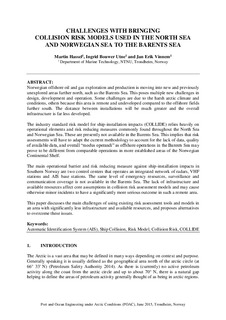| dc.contributor.author | Hassel, Martin | |
| dc.contributor.author | Utne, Ingrid Bouwer | |
| dc.contributor.author | Vinnem, Jan Erik | |
| dc.date.accessioned | 2018-04-11T13:47:50Z | |
| dc.date.available | 2018-04-11T13:47:50Z | |
| dc.date.created | 2015-10-19T09:14:13Z | |
| dc.date.issued | 2015 | |
| dc.identifier.citation | Proceedings - International Conference on Port and Ocean Engineering under Arctic Conditions. 2015, . | nb_NO |
| dc.identifier.issn | 0376-6756 | |
| dc.identifier.uri | http://hdl.handle.net/11250/2493711 | |
| dc.description.abstract | Norwegian offshore oil and gas exploration and production is moving into new and previously unexplored areas further north, such as the Barents Sea. This poses multiple new challenges in design, development and operation. Some challenges are due to the harsh arctic climate and conditions, others because this area is remote and undeveloped compared to the offshore fields further south. The distance between installations will be much greater and the overall infrastructure is far less developed. The industry standard risk model for ship-installation impacts (COLLIDE) relies heavily on operational elements and risk reducing measures commonly found throughout the North Sea and Norwegian Sea. These are presently not available in the Barents Sea. This implies that risk assessments will have to adapt the current methodology to account for the lack of data, quality of available data, and overall “modus operandi” as offshore operations in the Barents Sea may prove to be different from comparable operations in more established areas of the Norwegian Continental Shelf. The main operational barrier and risk reducing measure against ship-installation impacts in Southern Norway are two control centers that operates an integrated network of radars, VHF stations and AIS base stations. The same level of emergency resources, surveillance and communication coverage is not available in the Barents Sea. The lack of infrastructure and available resources affect core assumptions in collision risk assessment models and may cause otherwise minor incidents to have a significantly more serious outcome in such a remote area. This paper discusses the main challenges of using existing risk assessment tools and models in an area with significantly less infrastructure and available resources, and proposes alternatives to overcome these issues. | nb_NO |
| dc.language.iso | eng | nb_NO |
| dc.publisher | Port and Ocean Engineering under Arctic Conditions, POAC | nb_NO |
| dc.title | Challenges with bringing collision risk models used in the north sea and norwegian sea to the Barents Sea | nb_NO |
| dc.type | Journal article | nb_NO |
| dc.type | Peer reviewed | nb_NO |
| dc.description.version | acceptedVersion | nb_NO |
| dc.source.pagenumber | 13 | nb_NO |
| dc.source.journal | Proceedings - International Conference on Port and Ocean Engineering under Arctic Conditions | nb_NO |
| dc.identifier.cristin | 1281404 | |
| dc.relation.project | Norges forskningsråd: 223254 | nb_NO |
| dc.description.localcode | © 2015 Port and Ocean Engineering under Arctic Conditions. Available at http://www.poac.com/Papers/2015/author_index.htm | nb_NO |
| cristin.unitcode | 194,64,20,0 | |
| cristin.unitname | Institutt for marin teknikk | |
| cristin.ispublished | true | |
| cristin.fulltext | postprint | |
| cristin.qualitycode | 1 | |
